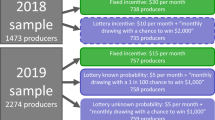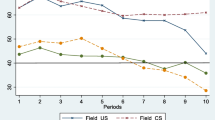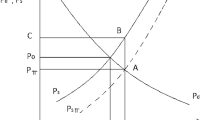Abstract
This paper continues the research implemented in previous work of (Schreider et al. in Environ. Model. Assess. 15(4):223–238, 2010) where a game theoretic model for optimal fertilizer application in the Hopkins River catchment was formulated, implemented and solved for its optimal strategies. In that work, the authors considered farmers from this catchment as individual players whose objective is to maximize their objective functions which are constituted from two components: economic gain associated with the application of fertilizers which contain phosphorus to the soil and environmental harms associated with this application. The environmental losses are associated with the blue-green algae blooming of the coastal waterways due to phosphorus exported from upstream areas of the catchment. In the previous paper, all agents are considered as rational players and two types of equilibria were considered: fully non-cooperative Nash equilibrium and cooperative Pareto optimum solutions. Among the plethora of Pareto optima, the solution corresponding to the equally weighted individual objective functions were selected. In this paper, the cooperative game approach involving the formation of coalitions and modeling of characteristic value function will be applied and Shapley values for the players obtained. A significant contribution of this approach is the construction of a characteristic function which incorporates both the Nash and Pareto equilibria, showing that it is superadditive. It will be shown that this approach will allow each players to obtain payoffs which strictly dominate their payoffs obtained from their Nash equilibria.
Similar content being viewed by others
References
Chankong, V., & Haimes, Y. (1983). Multiobjective decision making: theory and methodology. New York: North-Holland.
Deng, X., & Papadimitriou, C. H. (1994). On the complexity of cooperative solution concepts. Mathematics of Operations Research, 19(2), 257–266.
Dilon, J. L. (1962). Application of game theory in agricultural economics: review and requiem. Australian Journal of Agricultural Economics, 6(2), 20–35.
Dinar, A. (2004). Cooperation in managing trans boundary water resources: evaluation, approaches and experiences. In Proceedings of 4th Rosenberg international forum on water policy.
Dinar, A., Farolfi, S., Patrone, F., & Rowntree, K. (2008). To negotiate or to game theorize: evaluating water allocation mechanisms in the Kat Basin, South Africa. In A. Dinar, J. Albiac, & J. Sanchez-Soriano (Eds.), Game theory and policy making in natural resources and the environment. London: Routledge.
Eleftheriadou, E., & Mylopoulos, Y. (2008). Game theoretical approach to conflict resolution in transboundary water resources management. Water Resources Planning and Management, 134(5), 466–473.
Filar, J. A., & Gaertner, P. S. (1997). A regional allocation of world CO2 emission reductions. Mathematics and Computers in Simulation, 43, 269–275.
Gurvich, V., & Schreider, S. (2011). Stable families of coalitions for network resource allocation problems. In L. A. Petrosjan & N. A. Zenkevich (Eds.), Contribution to game theory and management (IV). Graduate School of Management, St. Petersburg University (pp. 223–230).
Petrosjan, L., & Zenkevich, N. (1996). Game theory. Series on optimization: Vol. 3. Singapore: World Scientific.
Read, Sturgess and Associates (1999). Benefits and costs for reducing frequency of algal blooms in the Glenelg–Hopkins CMA region (Technical report).
Roe, L. T. (1996). Application of game theory in agricultural economics: discussion. American Journal of Agricultural Economics, 78, 761–763.
Schlapp, J., & Schreider, S. (2007). Survey of farmer management of phosphorus application in the Hopkins River catchment, for use in game-theoretic modeling. In MODSIM 2007 international congress on modelling and simulation (pp. 2361–2367).
Schreider, S., Zeephongsekul, P., & Fernandes, M. (2010). Modelling the optimal strategies of fertiliser application using the game-theoretic approach. Environmental Modeling & Assessment, 15(4), 223–238.
Shapley, L. S. (1953). A value for n-person games. In H. Kunh & A. Tucker (Eds.), Contributions to the theory of games (Vol. II). Princeton: Princeton University Press.
von Neumann, J., & Morgenstern, O. (1944). Theory of games and economic behavior. New York: Wiley.
Vorob’ev, N. N. (1977). Game theory: lectures for economists and systems scientists. New York: Springer.
Acknowledgements
We acknowledge Julia Schlapp for designing and implementing the household survey in the Hopkins River catchment. We are especially grateful to Professor Vera Bergelson from Rutgers University, NJ, for many challenging discussions on cooperative behavior. Finally, the authors thank the anonymous reviewers for their constructive and valuable comments which helped to improve the previous version of this paper.
Author information
Authors and Affiliations
Corresponding author
Appendix
Appendix
This appendix provides details for obtaining the optimal solutions of expressions (7) and (8).
For \(u_{i}(\alpha_{i}^{r})\) the first derivative is:

to maximize \(u_{i}(\alpha_{i}^{r})\) we solve \(\frac{\partial u_{i}}{\partial\alpha_{i}^{r}}=0\), however the obtained solution must satisfy \(A_{r1}\leq\alpha_{i}^{r}\leq A_{r1}\) for i=1,2,…,N and r=1,2,…,R. We outline the following steps to find the solution:
Step 1.
Assume \(\alpha_{i}^{r}>\frac{L}{(1-q_{i}^{r})}\) hence \(I(\alpha_{i}^{r}(1-q_{i}^{r})>L)=1\). Then from (A.1) we obtain:

If \(\alpha_{i}^{r_{*}}>\frac{L}{(1-q_{i}^{r})}\) is hold, \(\alpha_{i}^{r_{*}}\) is a candidate solution for maximizing \(u_{i}(\alpha_{i}^{r})\) (the second derivative condition as shown in the main text is satisfied). Otherwise, \(\alpha_{i}^{r_{*}}\) is not feasible and candidate solutions are \(\frac{L}{(1-q_{i}^{r})}+\epsilon\) (where ϵ is a very small value close to 0), A r1 if \(A_{r1}>\frac{L}{(1-q_{i}^{r})}\) and A r2 if \(A_{r2}>\frac{L}{(1-q_{i}^{r})}\).
Step 2.
Assume \(\alpha_{i}^{r}\leq\frac{L}{(1-q_{i}^{r})}\) hence \(I(\alpha_{i}^{r}(1-q_{i}^{r})>L)=0\) and we obtain:

If \(\alpha_{i}^{r_{**}}\leq\frac{L}{(1-q_{j}^{r})}\) is true, \(\alpha_{i}^{r_{**}}\) is a candidate solution for maximizing \(u_{i}(\alpha_{i}^{r})\) (the second derivative as shown in the text is satisfied). Otherwise \(\alpha_{i}^{r_{**}}\) is not feasible and candidate solutions are \(\frac{L}{(1-q_{i}^{r})}\), A r1 if \(A_{r1}\leq\frac{L}{(1-q_{i}^{r})}\) and A r2 if \(A_{r2}\leq\frac{L}{(1-q_{i}^{r})}\).
Step 3.
Evaluate candidate solutions obtained from Step 1 and Step 2 and see which one maximize the following term (which is the part of \(u_{i}(\alpha_{i}^{r})\) that encompasses \(\alpha_{i}^{r}\)):

For Z(s), the first derivative is:

Since \(\frac{\partial Z(s)}{\partial\alpha_{i}^{r}}\) does not contain any \(\alpha_{j}^{r}\)s (i≠j), Steps 1 to 3 can be applied similarly to obtain the solution for (A.2).
Rights and permissions
About this article
Cite this article
Schreider, S., Zeephongsekul, P., Abbasi, B. et al. Game theoretic approach for fertilizer application: looking for the propensity to cooperate. Ann Oper Res 206, 385–400 (2013). https://doi.org/10.1007/s10479-013-1381-9
Published:
Issue Date:
DOI: https://doi.org/10.1007/s10479-013-1381-9




